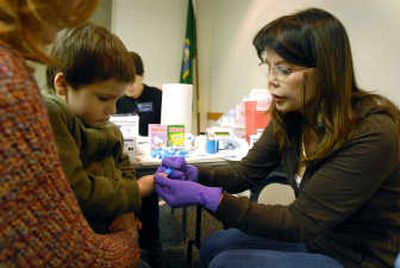Kids tested for lead levels

Four-year-old Lucas Cusano braved last week’s blood test like a trouper.
He barely moved when a nurse jabbed his finger to draw a trace of blood to test it for lead.
And Lucas was satisfied when he got a SpongeBob bandage to cover the test site.
His sister, Cecilia Cusano, had a tougher time. The pinprick caused her finger to bleed for a few moments, leaving a red spot on her mom’s jeans.
But the tests brought good news. Both children had low levels of lead in their blood, which was something of a relief to their mother, Sherol Cusano.
They were among 30 children ages 6 and younger who were tested last week at the East Central Community Center under a grant to the Lands Council in Spokane. None of the children had elevated levels of lead in their blood, said Nicole Powell, who is running the testing program.
The Cusano children attend Head Start, and their mother learned about the testing through the preschool program.
“We lived in an old house in Palouse that was built in 1880,” she said, explaining that she wanted to make sure that none of the house’s old lead-based paint had gotten into her children’s bloodstreams.
“I didn’t think the kids would ever eat paint,” she said, “but they eat Play-Doh and crayons.”
The Lands Council has started documenting the levels of lead in children’s blood through a small two-year grant from the U.S. Environmental Protection Agency. It is one of a few such grants nationwide and a first-time effort in Spokane to investigate possible lead problems in children on a communitywide level.
In last week’s testing at East Central and a January testing event at the West Central Community involving 34 children, no children were found with elevated lead level, Powell said. One child had a moderate level.
For the past several years, the Lands Council has sought out low-income families, non-English speaking residents and others to warn them of the hazards of lead contamination, including possible learning disabilities and other health problems. The testing efforts arose from the nonprofit agency’s longtime work on lead contamination, particularly from mining wastes that have washed downstream in the Spokane River from North Idaho.
Former industrial sites also are identified as risks for contamination, including a former BNSF Railway property just east of the Hillyard business district. Lead can be tracked into homes on muddy shoes or blown around in the wind from contaminated soils. BNSF is planning a voluntary cleanup of its contamination between the 4800 and 5300 blocks of North Ferrall Street on the west side of the street.
Homes built before 1950 are likely to have old lead paint, which is a hazard if it is allowed to peel off where it can be picked up and eaten by toddlers.
The $72,000 EPA grant was used to purchase a blood-screening device that gives quick readings and requires only a tiny sample of blood. No individual records are being kept, only the overall findings.
Hope Thommes, a registered nurse, administered the tests last week.
Charlie Tourtellotte, a resident of East Central, said he wasn’t surprised that his son, Nathaniel, 5, had a low level. He said he replaced the lead pipes in his family’s home.